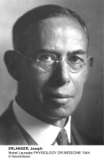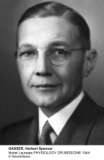


 |
||
|
1944 - Joseph Erlanger, Herbert Spencer Gasser
What characterizes the differentiation between nerve fibers? Erlanger and Gasser have proved that G?thli's assumption that conduction velocity in thick nerve fibres is greater than in thin ones, which was based on Thompson's formula for electrical-cable conduction, is correct. They showed that nerve fibres, according to their thickness and conduction velocities, could be divided into three main groups. A large number of other properties of the nerve fibres vary with the speed of conduction, as the threshold of excitation, the duration of the impulse, its rate of rise or its size. Erlanger and Gasser also showed that the three main types of fibres are non-uniformly distributed, with pain largely mediated by very thin, slowly conducting fibres, touch by rapidly conducting fibres, and skeletal muscles by fast fibres. Gasser also demonstrated that excitability changes in nerve's cross sections behave in a different manner in the three main types of fibres. Analyzing changes of excitability in a nerve influenced by a constant electrical current, Erlanger demonstrated that sensory nerves differed from motor nerves in many respects has far-reaching consequences.
|
||


